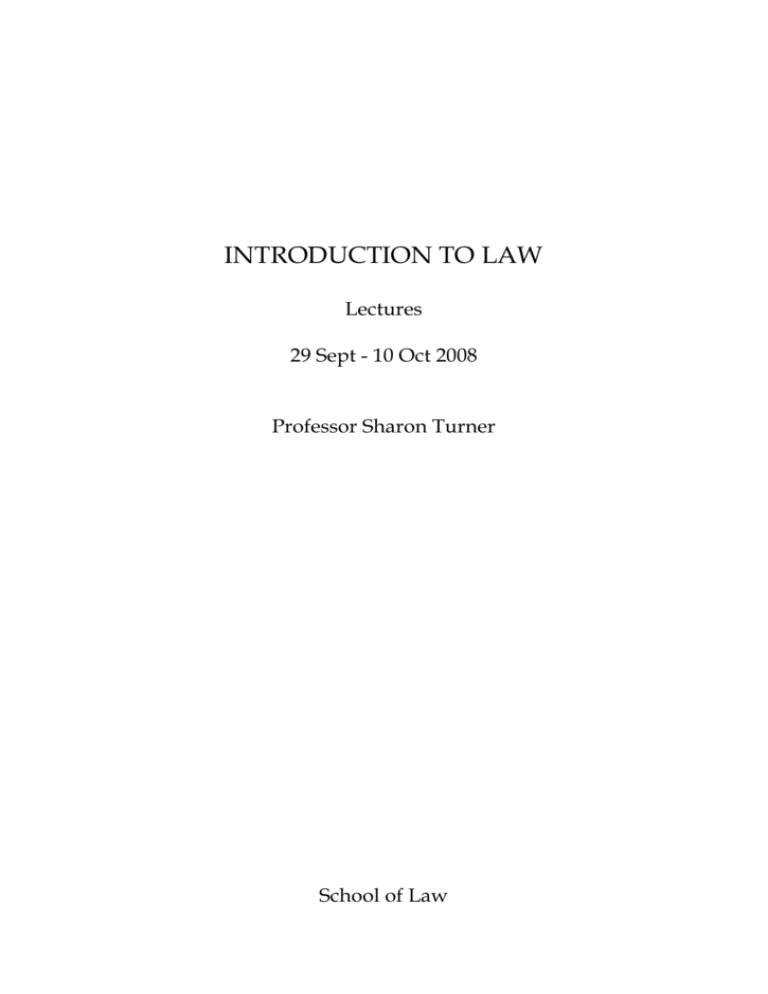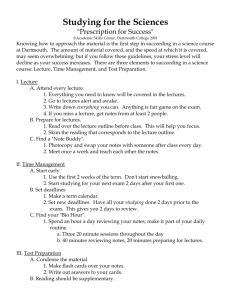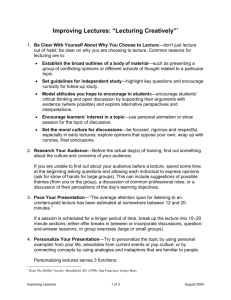INTRODUCTION TO LAW - Queen`s University Belfast
advertisement

INTRODUCTION TO LAW Lectures 29 Sept - 10 Oct 2008 Professor Sharon Turner School of Law 2 INTRODUCTION Welcome to the Introduction to Law lectures at Queen’s. The lectures, which will be given as part of the overall induction programme in the School of Law, are intended to provide an overview of the key features of the legal system(s) that you will be studying over the coming years. Of course, the fact that your studies will last for several years means that you will develop a fuller understanding of those features only as you approach the end of your studies. However, the themes to be examined over the next two weeks are so elemental to the study of law that they merit “frontloading” in the overall curriculum. The lectures should therefore be regarded as foundational in nature or, put differently, as primers for many of the other subjects that you will read within your degree pathway. One point that it is important to bear in mind as you attend the lectures is that we now live in a society where a number of legal systems intersect with one another and impact upon the way in which we study law. For instance, Queen’s is a university situated in Northern Ireland, which has its own legal system, court structures, and legislature (among other things). However, Northern Ireland, in turn, is a part of the United Kingdom (UK), and the Northern Ireland legal system and institutions are closely linked to those of the rest of the UK. At the same time, the UK is a Member State of the European Union (EU), and EU law has very important implications for many aspects of our legal order. So too has the European Convention on Human Rights (ECHR). And so on … The lectures will begin by taking you through the syllabi for the different courses you will read this year, and by explaining how they fit together. They will then consider the sources of law that are central to the remainder of your studies in year 1 and beyond, and also the main courts that you will encounter. Week two begins with lectures on statutes and on styles of legal writing and citation, and next it has lectures on “precedent” and “statutory interpretation” (as well as one on using the law library and conducting legal research). “Precedent” and “statutory interpretation” are generally regarded as definitive of the common law system of England and Wales and Northern Ireland, and you will see, in a rudimentary form, what they are and how they work. You will also be introduced to the impact that other legal systems – primarily EU law and the ECHR – have had in these areas. READING The readings for the course are listed under each of the lecture summaries (below), and you must read all of the noted materials. Although you will not have the opportunity to discuss these materials in a tutorial setting – tutorials start, instead, in the other level 1 modules – it is imperative that you read around the topic and start to develop an understanding of the nature of the subject. Law is a literature intensive degree programme, and you will be required to read a wide variety of sources 3 during your studies. The reading lists below thus include examples drawn from statute law, case law, books, and articles. Students are, for these purposes, also required to purchase B. Dickson, The Legal System of Northern Ireland, SLS Legal Publications, Belfast, 5th ed, 2005 (the book may be purchased directly from the publisher – which is situated at 50 Malone Road – for the specially reduced price of £20). Dickson is not only required reading for several of the Introduction to Law lectures; it is also the most comprehensive book on the Northern Ireland legal system. You will thus have many occasions to refer to it in the future. In addition to Dickson, students should be aware that there are many other books on the wider UK legal system and its processes. None of these has been prescribed for the course, although students are encouraged to consult and/or buy them by way of further reading. Some of the more prominent titles include: 1. Malleson, K., The Legal System, 3nd edition (Oxford University Press, 2007), available in the law library at KL11/MALL 2. Slapper, G. and Kelly, D., The English Legal System, 8th edition (London: Cavendish, 2006), available in the law library at KL11/SLAP 3. Ingman, T., The English Legal Process, 11th edition (Oxford University Press, 2006), available in the law library at KL11/INGM 4. Bradney, A; Cownie, F; Masson, J; Neal, A; Newell, D., How to Study Law, 5th edition (London, Sweet and Maxwell, 2005), available in the law library at KL131.35/BRAD 5. Glanville Williams, Learning the Law, 13th edition (London: Sweet & Maxwell, 2002), available in the law library at KL131.35/WILL ASSESSMENT There is no formal assessment procedure for Introduction to Law. However, all students are required to complete a short case note exercise, which is to be undertaken during the first week. Here, students should choose any case – whether found on-line or in hard copy in the library – and write a corresponding summary of no more than 250 words. The summary should, among other things, note the court that delivered the judgment; the parties to the dispute; the core facts; the legal issues; and the outcome. The case summary is to be submitted to the Law School Office by no later than 4:30pm pm on Thursday 9th Oct 2007 (students must sign the student list when 4 submitting the summary). Students should note that failure to complete the case exercise will be viewed as a serious progression issue and the School will decide on a case-by-case basis whether a student should be allowed to complete year one. Remember, the topics covered in the Introduction to Law lectures are central to the wider degree programme. Exercises of this kind are therefore intended to help you begin the process of reading and digesting the law (in this instance, in the form of case law). 5 THE LECTURES The lectures are held at the times and venues listed below. Most of the lectures will be given by Professor Sharon Turner. In addition to her student office hours (listed in the School of Law lobby), she can be contacted at s.turner@qub.ac.uk. Mr John Knowles, the Senior Law Librarian, will also give some of the lectures (j.knowles@qub.ac.uk ). Introducing the Law Degree & Skills Policy Mon 29th Sept 2008, 1.00-2.00pm DKB/LG/115 Prior to this lecture, you will have been officially welcomed by the Head of School and Director of Education and given some general information about what a law degree is, and what you can expect from it (and it from you). This lecture is designed to build on the welcome and general orientation process by bringing you through the content of the courses that you will be studying in semester 1. It is important to remember that you need not worry about the detail of the courses at this stage, as you will be expected to master them only when have taken the lectures and tutorials (although questions at this stage are of course welcome). This lecture should therefore be regarded as a mapping exercise that will point you towards questions of skills progression, assessment, teaching methodology, etc. Reading There is no follow-up reading for this lecture. Sources of Law Tuesday 30th Sept 2008, 4.00-5.00pm Peter Frogett Centre GO7 This lecture will take you through the basics of the key sources of law operating in the UK and introduce some of the problems associated with them. This session will also refer to sources of law that originate outside the UK but which affect day-to-day life here, most notably EU law and international human rights law. Court Structures Wednesday 1st Oct 1.00-2.00pm DKB/LG/115 Understanding the court structures is another central feature of the UK’s legal system and the study of law. This lecture will address the main features of the court system and will address the hierarchy in the court system; the relationship between courts “inside” and “outside” the UK; and the appointment of judges. In addition 6 the lecture will address wider thematic questions such as, does the composition of the bench reflect demographic and socio-economic patters in wider society? Reading Dickson, chpt 2 (on sources). Kate Malleson, The Legal System, 3nd edition (Oxford University Press, 2007), ch 17, available through Queen’s On-line and in the law library at KL11/MALL Human Rights Act 1998 (http://www.opsi.gov.uk/acts/acts1998/19980042.htm) Judgments Wednesday 1st Oct 2008, 2.00-5.00pm DKB/LG/115 This lecture continues with the theme of judging, and focuses on the nature, form, and importance of judgments. It begins with a general overview of what judgments are and where they can be found, and it then examines the structure of two sample judgments (one of which will be a ‘UK’ judgment; the other a ‘European’). This analysis will provide some of the necessary background for the compulsory case summary exercise (see “Assessment”, above), as it will suggest ways in which cases might be read. It will also highlight the difference between a typical UK and European case by way of illustrating the fact that we now live in a society that is regulated by a multiplicity of overlapping legal systems. The lecture will also show students how IT can be used to find cases. This will involve use of a wide range of electronic sources, many of which can be accessed only through Queens On-Line. Reading Dickson, chpts 5-8 (on courts) Anthony Bradney et al, How to Study Law, 5th edition (London, Sweet and Maxwell, 2005), ch 5, available through Queen’s On-line and in the law library at KL131.35/BRAD Brooks v Metropolitan Police Commissioner [2005] UKHL 24, [2005] 2 All ER 489 Case 6/64, Costa v ENEL [1964] ECR 585 Any additional case of any court, i.e. for the assessment. 7 Statutes Monday 8th October 2008, 9.00-10.00am G06 PFC This lecture will introduce you to the layout and breakdown of a statute. Statute law is central to many legal disputes and cases, and important questions about the nature and meaning of a statute may arise (see too this week’s lectures on ‘Statutory Interpretation’). Taking a sample statute provided in your course materials - the lecture highlights points of terminology and drafting technique, and also some rudimentary points about interpretation. It will also identify some of the problems with reading statutes, for instance questions of repeal and overlap with other pieces of legislation. Reading Dickson, pp 51-85. Legal writing, Research & Citation Tuesday 7th Oct, 9.00-10.00am G07 PFC We will turn, in this lecture, to examine methods of legal writing and citation. Again, this is something that you will fully master only after you have gained more experience as law students. At the same time, there are a number of “dos” and “don’ts” that you should be aware of even at this early stage, as failure to observe some of the these can have very serious implications for your degree studies. The most important of these concerns plagiarism. Plagiarism, which is an academic offence, “is defined as the presentation of the work of others as the writer’s own without appropriate acknowledgment” (QUB Study Regulation 7.17). The lecture will thus give examples of plagiarism, explain how the university identifies plagiarism, and highlight the possible penalties for plagiarism. (On penalties see further Part 7 of the QUB Study Regulations). Reading There is no follow-up reading for this lecture, although students must familiarise themselves with the QUB Study Regulations. The Law Library and Legal Research Thursday 9th Oct 2008, 9 am- 10am (G06 PFC); 11 am- 12pm (G07 PFC) Understanding how to use a Law Library is a key skill for lawyers and students of the law. These two linked lectures delivered by the Senior Law Librarian at Queen’s 8 will introduce you to the Law Library and show you how get the most from its resources. The Law Library at Queen’s provides a vital learning environment and research gateway for students. It contains a vast range of legal source materials – ranging from court reports (containing judgments), legal periodicals or journals (containing analysis of legal developments by experts), books, and wider EU and international documentation. These lectures will begin by giving you an overview or ‘virtual’ tour of the Law Library at Queen’s – introducing you to its key materials and their location, including the textbooks and other module readings available from the Library’s issue desk and online. The enhanced learning support to be provided by a new library building in your final year will also be explained. The lecture will then move on to take a more detailed look at how undertake legal research – showing you how to find journal articles listed in module readings; key textbooks and other specialised books. The importance of the Library catalogue will also be considered as a way of exploring the Library’s book collection to supplement key textbooks and find current discussion of all aspects of law. In addition to the traditional ‘paper’ library, you will also be introduced to the extensive online law resources, highlighting the commercial legal databases available to you as a Queen’s student. You will be shown how online resources can be used to support independent research throughout your law degree. Reading There is no follow-up reading for this lecture, although you may find it useful to find online sources for reading listed for the other lectures in this series. Statutory Interpretation Thursday 9th Oct 2008, 2.00-5.00pm G06 PFC We turn in this lecture to consider rules of statutory interpretation. Judges, through the function of interpreting legislation, are in a (potentially) very powerful position, as they must read legislation and decide what it means within the context of a particular dispute. This raises very important questions about the limits to the judicial role, as an expansive approach to “interpretation” (more typically called the “purposive” approach) can result in judicial “legislation” (the task of making the law is, constitutionally speaking, one for Parliament). Is an expansive approach thereby to be rejected in all cases? Or is it correct that the courts should sometimes give legislation a meaning that moves beyond the “literal”? And what does European law have to say on the matter? 9 Precedent Friday 10th Oct 2008 10.00-11.00 G07 PFC 12noon-1.00pm G06 PFC 1.00-2.00pm G07 PFC The purpose of these lectures is to introduce students to the rules of precedent. Those rules entail, at their most basic, that a “lower court is obliged to follow a higher court’s decision in a similar case unless the previous decision can be ‘distinguished’” (Dickson, p 90) and, as has been indicated above, many commentators regard the rules of precedent them as central to the workings of the common law. However, it is now also said (by some) that the significance of the rules is overstated and that precedent is no longer as important as it once was. Is this the case? The lectures begin by mapping the rules of precedent and their critique and then turn to consider the rules with reference to a case study, namely the judgment of the House of Lords in Hill v Chief Constable of West Yorkshire [1989] AC 53. In that case, it was held that the police cannot be sued in negligence when investigating crime, as it would be contrary to public policy to allow that to happen. Is Hill still binding precedent? We will see the answer in a case that you will have already been referred to above in the “judgments” lecture, namely Brooks v Metropolitan Police Commissioner [2005] UKHL 24, [2005] 2 All ER 489. Reading Dickson, pp 85-93 Terence Ingman, The English Legal Process, 11th edition (Oxford University Press, 2006), ch 5, available through Queen’s On-Line and in the law library at KL11/INGM Hill v Chief Constable of West Yorkshire [1989] AC 53 Osman v Ferguson [1993] 4 All ER 344 Brooks v Metropolitan Police Commissioner [2005] UKHL 24, [2005] 2 All ER 489 Reading Dickson, pp 93-96 Fiona Cownie et al, English Legal System in Context, 4th ed (*Oxford University Press, 2007), ch 6, available through Queen’s On-Line and in the library at KL11/COWN Re Northern Ireland Human Rights Commission [2002] NI 236 Ghaidan v Mendoza [2004] 2 AC 557







